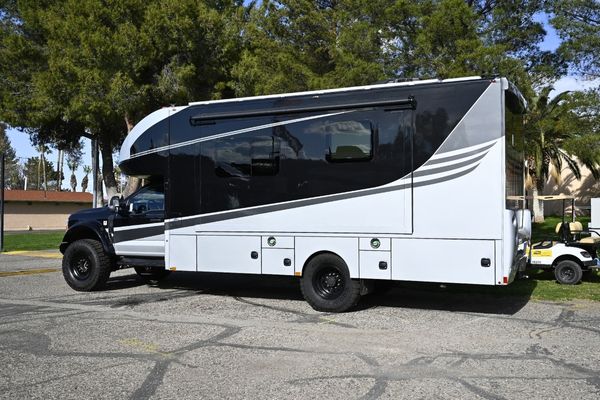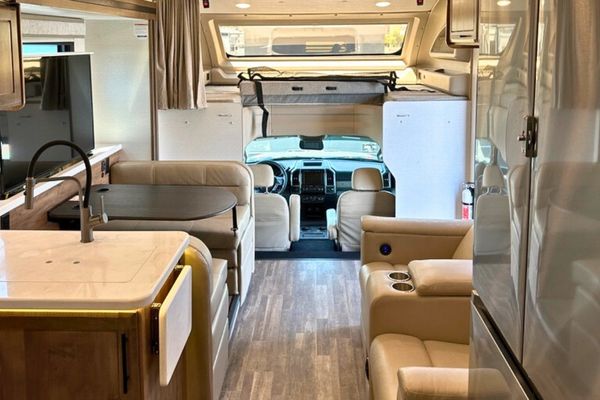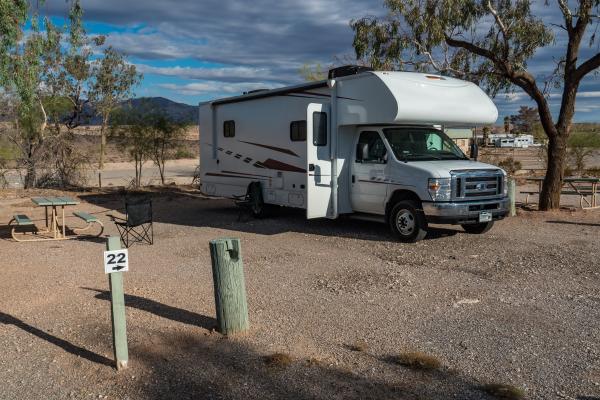
In the current series of articles, we are exploring different types of RVs. Last month, we focused on Class A motorhomes. This month, we will continue with motorized RVs and talk about Class C motorhomes, including units known as Super Cs.
About Class C Motorhomes
Class C and Super C motorhomes are built on van or truck chassis and sport the classic “cab over” feature — sleeping or storage space that extends out over the cab of the vehicle. These units come in a wide range of lengths, from approximately 19 feet to 40 feet. They are available with gas- or diesel-powered chassis and a broad array of floor plans, making Class C and Super C units attractive options for those looking for their first or next motorhome.

Features of Class C and Super C RVs
From 19-foot gas-powered motorhomes with simple floor plans to deluxe 40-foot Super C coaches built on diesel-powered Freightliner chassis, Class C and Super C units cover a wide range of budgets and features.
Historically, Class C units have been considered the smaller and less luxurious cousins to Class A motorhomes. However, that is no longer the case with the introduction of Super C RVs. The main difference between Class C and Super C motorhomes is that the former are constructed on small to medium truck chassis (often gas powered), while Super C motorhomes are built on larger diesel-powered truck chassis — frequently consumer versions from commercial manufacturers, most notably Freightliner. The cab portions of Super C units are spacious (like the overall living area) and bear a striking resemblance to smaller versions of highway tractors.
Want to walk through Class C and Super C RVs? Find out if a Family RV Association Convention and Expo is coming to a city near you.
Sleeping Capacity of a Class C Motorhome
Class C and Super C motorhomes tend to have larger sleeping capacities than Class A units (and certainly Class B motorhomes), because of the cab-over construction. This area typically is configured as a sleeping berth, although in some cases, the cab-over section incorporates storage or an entertainment center. With a main bed, a fold-down dinette, and a cab-over bunk, even the smallest Class C units tend to have a sleeping capacity of at least five or six people.

As Class C units increase in size, the sleeping capacity can grow significantly, with features such as sleeper sofas and bunks. It should be noted that while many late-model, entry-level, mid-market Class A units feature increased sleeping capacity compared to older models, the Class C family excels in this area.
In addition to the extra sleeping capacity, Super C units rival luxury Class A diesel units when it comes to amenities, and in some cases, they exceed the features offered in Class A units. From the inside, it can be difficult to determine whether one is looking at a high-end Class A or a Super C RV.
How Much Does It Cost to Buy a Class C RV?
Class C RVs start at around $70,000 and go up to approximately $250,000 for a high-end Super C. Class C motorhomes range from basic floor plans to fully featured models on the higher end, with the latter including amenities such as fireplaces, washer/dryers, etc.
The Pros and Cons of Buying a Class C RV
Given the wide array of sizes and prices, there truly is something for everyone in Class C and Super C offerings. If higher-end Super C units are within your price range, and you have decided on a motorhome, take the time to compare whether a Class A or a Super C suits you and your family better. Aside from differences in floor plans, engine types, etc., the overall advantage to Class C units compared to Class A tends to be the increased sleeping capacity. Again, this is not always the case with modern RVs, but it is almost always true if you’re considering older used units.

Fundamentally, however, there is no right or wrong choice here. It will come down to which floor plan appeals to you most, and perhaps to a preference for a particular RV brand, chassis, etc. Many luxury motorhome manufacturers produce both Class A and Super C RVs, so you can shop from within the same RV family.
Next month, we will discuss Class B and B-Plus units.
Want to see more articles like this one? Check out:
- Deciding on a Class A Motorhome
- Class B Motorhomes: Pros, Cons, and Tips for First-Time Buyers
- The Pros and Cons of Fifth-Wheel RVs
- Choosing Your Perfect RV
- Try Before You Buy: Why Renting an RV Makes Sense
 Steve Froese is a longtime member of FMCA, a nonprofit organization for owners of recreational vehicles, and writes the “Tech Talk” column for Family RVing magazine. He is an experienced RV owner and a certified RV technician in both the United States and Canada. Steve is also a licensed professional engineer in British Columbia and a busy professional musician.
Steve Froese is a longtime member of FMCA, a nonprofit organization for owners of recreational vehicles, and writes the “Tech Talk” column for Family RVing magazine. He is an experienced RV owner and a certified RV technician in both the United States and Canada. Steve is also a licensed professional engineer in British Columbia and a busy professional musician.


Leave a Reply